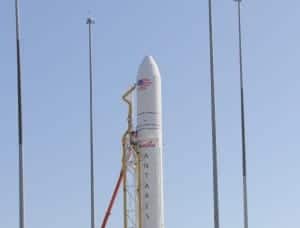Air Innovations’ client and NASA partner Orbital Sciences Corp. successfully launched Orbital’s Antares rocket from the new Mid-Atlantic Regional Spaceport (MARS) at the agency’s Wallops Flight Facility in Virginia. The test flight was the first launch from the pad at Wallops and the first flight of Antares launch system, whose rockets will be resupplying the International Space Station later this year. Air Innovations provided three water-cooled environmental control systems (ECUs), and a portable, air-cooled ECU that was built on a 25-foot trailer. These systems were among the largest ever designed and manufactured by Air Innovations.
Air Innovations’ President and CEO Michael Wetzel explained that, “On this and future Antares flights, Air Innovations’ ECUs are responsible for conditioning the key stages of the rocket, including its payload, during pre-launch.” First, the rocket is outfitted with its payload about a mile from the launch site. Then it is towed in a horizontal position to the site, a lengthy process during which the contents of the payload section are maintained at temperature, humidity, filtration and pressurization parameters unique to that particular flight’s payload. The portable ECU accompanies the rocket on its crawl to the pad, steadily supplying the payload’s specific needs.
Once at the pad, the rocket is raised into a vertical position. At that point, AI’s fixed systems, located deep in a bunker under the pad and managed from remote location, regulate the payload and the core stages’ environmental conditions until minutes before launch.
Each fixed ECU provides 1200 to 2200 cubic feet minute (CFM) airflow, 45 tons of cooling and 65 kilowatts of heating. There are three fixed systems and two in-line desiccant dryers to achieve minus 22 degrees Centigrade dew point. “The extremely dry dewpoint is needed to allow the fueling process to begin,” Wetzel said. He added, “The biggest challenge on this project is dealing with the wide range of inlet conditions… the units are 100 percent outside air on the coast of Virginia, in April. The temperature control range of 45 to 85 degrees Fahrenheit and the wide airflow range combined to make this a very complex refrigeration design at the tight tolerance stabilities the customer required.”
Air Innovations’ previous experience building custom environmental control systems for the aerospace industry includes:
- A fixed, explosion-proof, Class I, Division II system that operates in corrosive salt-air conditions while providing low humidity to a payload during its installation near the top of a 235-foot rocket. This project is at a U.S. Air Force base on the West Coast, where satellites are flown into polar orbit using expendable boosters.
- A portable system that maintains cleanroom-quality air for spot applications and portable isolators in a satellite assembly facility at another U.S. Air Force base, where a broad range of environmental inlet conditions have to be met. The system provides 3.5 tons of cooling with an air-cooled condenser, 3.5 kilowatts of heating, 1200 CFM airflow, and high efficiency particulate air (HEPA) filtration.

